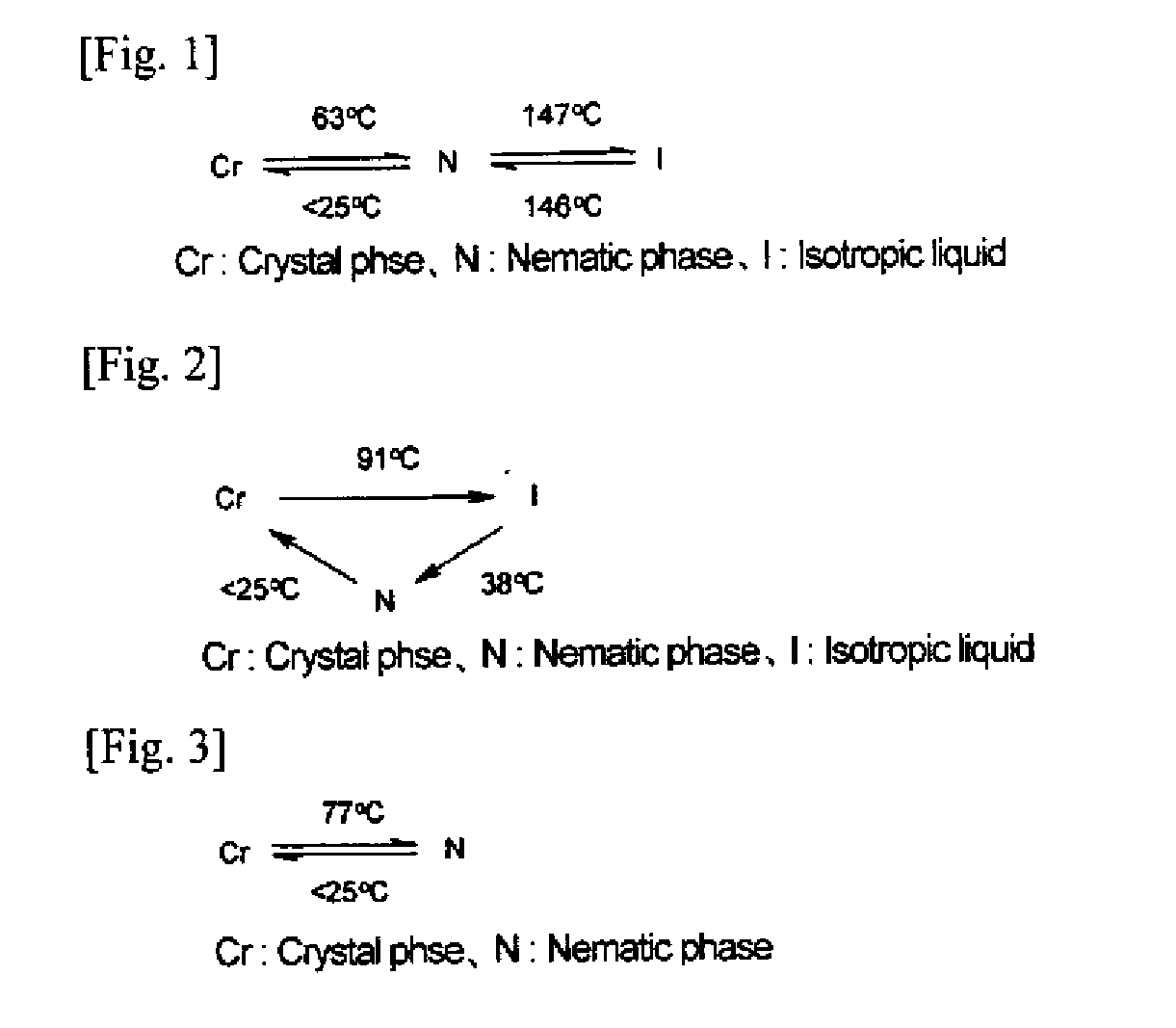Trifunctional (METH)acrylate compound and polymerizable composition containing same
a technology of trifunctional acrylate and polymerizable composition, applied in the field of new materials, can solve the problems of insufficient strength or residual stress-induced strain of polymer film, failure to achieve the effect of good heat resistance and optical characteristics
- Summary
- Abstract
- Description
- Claims
- Application Information
AI Technical Summary
Benefits of technology
Problems solved by technology
Method used
Image
Examples
example 1-13
Preparation of Trifunctional (Meth)Acrylate Compound No. 1
[0055]Trifunctional (meth)acrylate compound No. 1 was prepared by the following procedures in accordance with reaction scheme of [Formula 22] below:
[0056]In 17 ml of THF were dissolved 2.06 g (3.19 mmol) of phenol compound No. 1 and 2.21 g (4.78 mmol) of 3,4-di(6-acryloyloxyhexyloxy)benzoic acid, and 0.19 g (1.59 mmol) of 4-dimethylaminopyridine and 0.73 g (5.73 mmol) of diisopropylcarbodiimide were added to the solution while cooling with ice. The system was stirred at the same temperature for 10 minutes, followed by heating to room temperature, at which the stirring was continued for 3 hours. The solvent was evaporated under reduced pressure, and the residue was purified by silica gel column chromatography using a mixture of ethyl acetate and n-hexane as a developing solution to give a colorless transparent oily substance. Recrystallization from a mixed solvent of acetone and methanol followed by filtration yielded 2.8 g (8...
example 1-2
Preparation of Trifunctional (Meth)Acrylate Compound No. 2
[0060]Trifunctional (meth)acrylate compound No. 2 was prepared by the following procedures in accordance with reaction scheme of [Formula 23] below:
[0061]A mixture of 2.7 g (23.8 mmol) of methanesulfonyl chloride and 37 g of THF was cooled to or below −20° C. while stirring. A mixture of 10 g (21.6 mmol) of 3,4-di(6-acryloyloxyhexyloxy)benzoic acid, 3.35 g (25.9 mmol) of diisopropylethylamine, and 37 g of THF was added thereto dropwise while maintaining the system at −20° C. or lower. After completion of the addition, the system was stirred at that temperature for 30 minutes. A microspatula of 4-dimethylaminopyridine and 3.35 g (25.9 mmol) of diisopropylethylamine were added thereto, and a mixture of 8.97 g (22.7 mmol) of phenol compound No. 2 and 37 g of THF was further added while maintaining the system at or below −10° C., followed by stirring at that temperature for 2 hours. The reaction mixture was washed with water, and...
example 1-3
Preparation of Trifunctional (Meth)Acrylate Compound No. 3
[0065]Trifunctional (meth)acrylate compound No. 3 was prepared by the following procedures in accordance with reaction scheme of [Formula 24] below:
[0066]In 108 ml of THF were dissolved 9.20 g (14.2 mmol) of phenol compound No. 1 and 7.00 g (18.5 mmol) of 3,4-di(6-acryloyloxypropyloxy)benzoic acid, and 0.87 g (7.12 mmol) of 4-dimethylaminopyridine and 2.80 g (22.2 mmol) of diisopropylcarbodiimide were added to the solution while cooling with ice. The system was stirred at the same temperature for 30 minutes, followed by heating to room temperature, at which the stirring was continued for an additional 16 hour period. Acetone was added to the reaction mixture, and the precipitate thus formed was collected by filtration. The solvent was removed by evaporation under reduced pressure, and toluene was added thereto. The precipitate formed was collected by filtration, and the solvent was removed by evaporation under reduced pressur...
PUM
| Property | Measurement | Unit |
|---|---|---|
| temperature | aaaaa | aaaaa |
| boiling point | aaaaa | aaaaa |
| boiling point | aaaaa | aaaaa |
Abstract
Description
Claims
Application Information
 Login to View More
Login to View More - R&D
- Intellectual Property
- Life Sciences
- Materials
- Tech Scout
- Unparalleled Data Quality
- Higher Quality Content
- 60% Fewer Hallucinations
Browse by: Latest US Patents, China's latest patents, Technical Efficacy Thesaurus, Application Domain, Technology Topic, Popular Technical Reports.
© 2025 PatSnap. All rights reserved.Legal|Privacy policy|Modern Slavery Act Transparency Statement|Sitemap|About US| Contact US: help@patsnap.com



